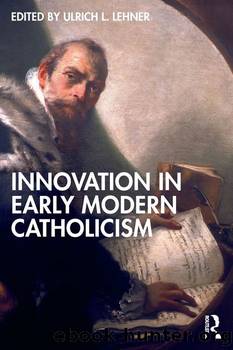Innovation in Early Modern Catholicism by Ulrich L. Lehner

Author:Ulrich L. Lehner [Lehner, Ulrich L.]
Language: eng
Format: epub
ISBN: 9781032051970
Barnesnoble:
Publisher: Taylor & Francis
Published: 2021-11-30T00:00:00+00:00
The ultramontane counter-offensive and the dawn of a new era
The epoch-defining events that began in 1789 shipwrecked the radical conciliarist blueprint for reform that had seemed, at least in certain quarters, so close to realization. The French Revolution and its aftermath have tremendously overshadowed the fact that the 1780s saw âan incipient revolution in the Catholic Church.â75 Against all odds, the papacy, which seemed to be on life support in the 1790s, somehow emerged stronger when the dust settled. In one of the supreme ironies of church history, the French Revolution was the beginning of the end for radical conciliarist reform, not for papal power.76 Pius VIIâs Concordat with Napoleon in 1801 was the decisive turning point for two reasons. First, the French state treated directly with the papacy and sidelined the Constitutional clergy. Second, Pius VII cleared the board of all French bishops with the bull Tam Multa (1801) and reconstructed that ancient and proud episcopacy on his own authority. This act would have been unthinkable in the ancien régime and was the antithesis of the vaunted âGallican Liberties.â In retrospect, it almost seems a proleptic realization of the infallible and jurisdictionally supreme papacy envisioned by the maximalists at Vatican I. But, crucially, it was basically accepted â either in principle or as a necessary evil â because the Most Christian King was dead at the hands of his own people and the pope was the strongest point around which Catholics could rally in a new and chaotic world. French Catholics, suffering under the confusion of parallel hierarchies, needed clarity and order, and so did Napoleonâs government. The pope was the only man who could deliver this.
Mauro Cappellari (1765â1846), author of The Triumph of the Holy See (1799) and the future Gregory XVI (pope from 1832 to 1846), is the most famous exemplar of the style of ultramontane thought that was steadily gathering momentum at the turn of the nineteenth century. Cappellari was one of an international network of polemicists and theologians that rose to the defense of the papacy against the variety of anti-ultramontane and statist forces inside and outside the Church. This network, which Dale Van Kley has termed the âUltramontanist Internationalâ77 included Giovanni Marchetti (1753â1829), Alfonso Muzzarrèlli (1749â1813), Giovanni Vincenzo Bolgeni (1733â1811), Francesco Antonio Zaccaria (1714â1795), Cardinal Giacinto Sigismondo Gerdil (1718â1802), and François-Xavier de Feller (1735â1802).78 The simple message of these authors appealed to many in an era of upheaval. In their counter-Revolutionary and counter-Enlightenment narrative, Catholics were locked in a life or death struggle and must rally around the Vicar of Christ. The satanic principles of 1789 were the bastard children of a union of Jansenist heretics, the skeptical philosophes, and the cynical encroachments of power hungry Erastian monarchs and statesmen. In stark contrast to the proto-ecumenical overtures of some philo-Jansenists and Gallicans, for these authors the chaos of 1789 was merely the latest link in a chain of errors that went back to the Protestant Reformation and its rejection of divinely constituted spiritual and temporal authorities.
Download
This site does not store any files on its server. We only index and link to content provided by other sites. Please contact the content providers to delete copyright contents if any and email us, we'll remove relevant links or contents immediately.
Women and Jewish Marriage Negotiations in Early Modern Italy by Howard Tzvi Adelman(408)
Warrior King by Wilbur Smith(365)
18 real-life stories of serial killers and murderers with solved and unsolved killings from the USA, UK, Europe, and beyond. by Ben Oakley(287)
The Battle of Austerlitz by 50minutes(280)
Violence and Emotions in Early Modern Europe by Susan Broomhall;Sarah Finn;(274)
Who's Who in the Zulu War, 1879: The British by Adrian Greaves Ian Knight(272)
The American Crisis by Unknown(266)
Youth, Heroism and War Propaganda: Britain and the Young Maritime Hero, 1745â1820 by D. A. B. Ronald(239)
The Seeker by S. G. MacLean(229)
The Origins of French Absolutism, 1598-1661 by Alan James(220)
The Dutch East India Company and British East India Company: The History and Legacy of the Worldâs Most Famous Colonial Trade Companies by Charles River Editors(213)
The Traitor of Colditz by Robert Verkaik(200)
Invisible Worlds by Peter Marshall(200)
A Genius for Confusion by Richard M. Fried(199)
The Thirty Years War â Complete by Friedrich Schiller(199)
Fires of Faith by Catholic England under Mary Tudor(196)
Interest and Connection in the Eighteenth Century by Jacob Sider Jost(194)
The Opium Wars: Exploring the Addiction of Empires from Beginning to End by Ramos Adrian & Compacted History(193)
The Slave Trade in Africa by Simon Webb;(193)
